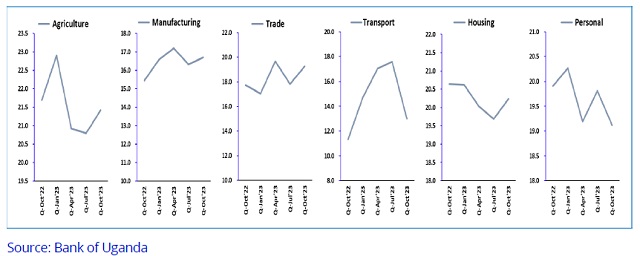
Bank of Uganda projects the economy to grow at 6% in FY2023/24 up from 5.2% a year before
Kampala, Uganda | ISAAC KHISA | Uganda’s consumers recorded a 7.8% increase in borrowings for the three months to October, while lenders’ approval rate for loans in value terms decreased since July 2023, according to the Bank of Uganda. This indicates consumers’ high appetite for loans as interest rates ease following a decline in the central bank’s benchmark lending rate.
Consumer loan requests rose from Shs 6.0 trillion in July to Shs 8.7 trillion in October while the value of approved loans rose from Shs 3.9 trillion to Shs 5.1 trillion over the same period.
BoU cites the increase in demand for loans to the building up of inventory to meet the anticipated festive season demand, coupled with the demand from education institutions to meet their working capital and operational needs.
“Private credit sector growth remained weak in most sectors and weakened further during the review period in the trade, transport, communications, and personal loans sectors,” BoU said in its December 2023 State of the Economy report.
“Although still weak, PSC growth ticked up in agriculture, manufacturing, housing, and business services.”
Similarly, the Stanbic Purchasing Managers’ Index (PMI) increased from 52.4 in October to 53.4 in November 2023 – which is above the historical average of 52.6%, signaling an improvement in business conditions.
Last August, the BoU cut its benchmark lending rate (the central bank rate) by 50 basis points to 9.5% after year-on-year inflation dropped below its medium-term target of 5%. In December last year, the central bank’s Monetary Policy Committee kept the CBR unchanged, the second in a row to keep inflation to the desired level, while at the same time supporting growth in private sector investment and socio-economic transformation. This saw lending rates to consumers remain relatively unchanged at 20.6% over the same period.
However, declines in lending rates were noticeable for a few sectors, such as personal loans, transport, and communications. At the same time, marginal increases were observed in the agriculture, manufacturing, trade, and housing sectors
FY2023/24 growth projections
The BoU data also indicates that the economy is projected to continue recovering, with growth accelerating from 5.2% in FY2022/23 to 6.0% in FY2023/24, supported by the continued recovery of activity in the industry, agriculture, construction, and services.
“Growth will also be supported by continued Foreign Direct Investment inflow, especially into the extractive sector, and government investments in growth-enhancing programs such as the Parish Development Model and other infrastructures,” BoU said, adding that in the medium term, growth is projected at 7% driven by oil production and export activities.
Nevertheless, BoU notes that the growth outlook remains uncertain, with the balance of risks tilted to the downside citing several factors including adverse weather conditions impacting agricultural production, financial constraints on budgetary spending caused by high external finance costs, restricted household consumption, and private investments due to tight domestic credit conditions, and potential spikes in global commodity prices triggered by escalating geopolitical tensions, particularly in the Middle East.
Also, the country’s financial regulator, said the slower global and regional economic activity due to high-for-longer interest rates and lower trade could lead to lower external demand for Uganda’s exports, which could constrain aggregate demand further.
On the upside, domestic growth could surpass baseline projection if inflation in advanced economies declines faster than expected prompting the loosening of monetary policies or weather conditions to turn out favorable.
Elsewhere around the globe, growth is expected to slow down in many advanced economies, especially in the US and Europe, where the importance of bank finance is relatively high and where the drag on incomes from higher energy costs has been particularly strong.
The US output growth is expected to decelerate to 1.5% in 2024 from 2.4% as COVID-19 savings dwindle and the full effects of monetary policy tightening take hold. Similarly, the growth in the Euro Area and the United Kingdom are expected to remain weak in 2024 owed to inflation and tightening monetary policies.
The post Demand for loans surges as lending rates reduce appeared first on The Independent Uganda:.



